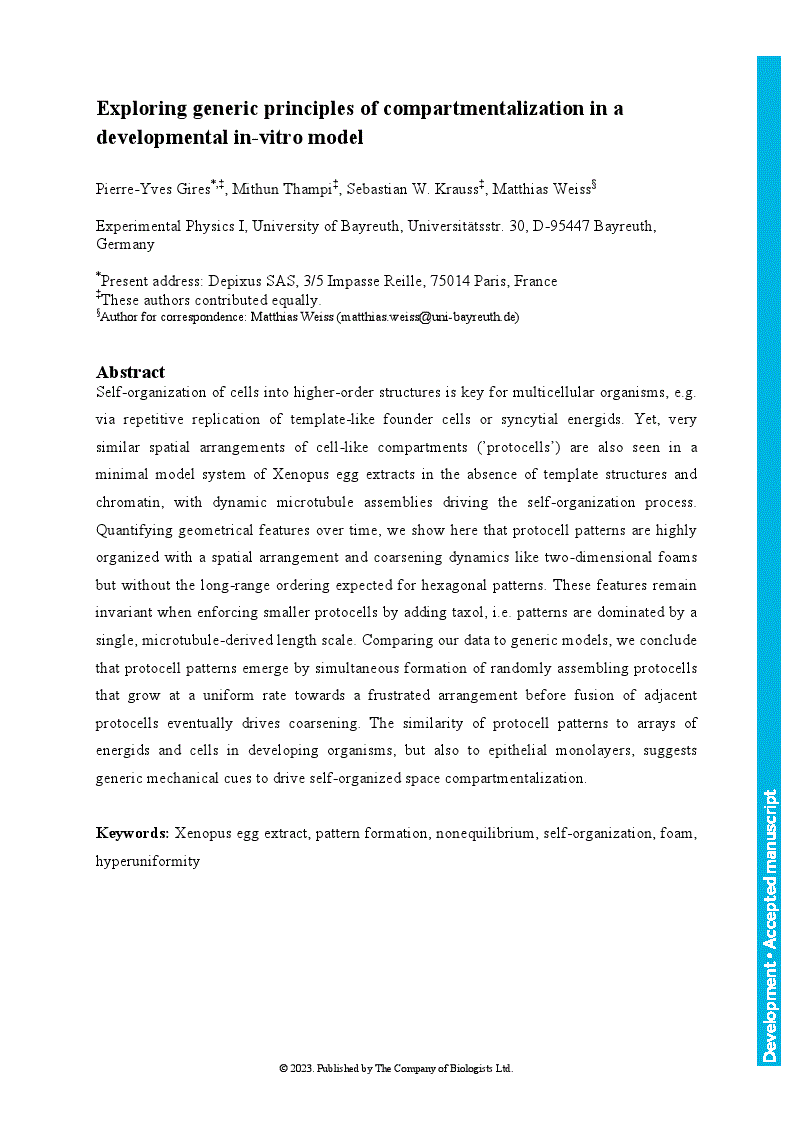Self-organization of cells into higher-order structures is key for multicellular organisms, e.g. via repetitive replication of template-like founder cells or syncytial energids. Yet, very similar spatial arrangements of cell-like compartments (’protocells’) are also seen in a minimal model system of Xenopus egg extracts in the absence of template structures and chromatin, with dynamic microtubule assemblies driving the self-organization process. Quantifying geometrical features over time, we show here that protocell patterns are highly organized with a spatial arrangement and coarsening dynamics like two-dimensional foams but without the long-range ordering expected for hexagonal patterns. These features remain invariant when enforcing smaller protocells by adding taxol, i.e. patterns are dominated by a single, microtubule-derived length scale. Comparing our data to generic models, we conclude that protocell patterns emerge by simultaneous formation of randomly assembling protocells that grow at a uniform rate towards a frustrated arrangement before fusion of adjacent protocells eventually drives coarsening. The similarity of protocell patterns to arrays of energids and cells in developing organisms, but also to epithelial monolayers, suggests generic mechanical cues to drive self-organized space compartmentalization.
Exploring generic principles of compartmentalization in a developmental in-vitro model

Present address: Depixus SAS, 3/5 Impasse Reille, 75014 Paris, France
These authors contributed equally to the work
- Award Group:
- Funder(s): Volkswagen Foundation
- Award Id(s): Az. 92738
- Funder(s):
- Award Group:
- Funder(s): EliteNetwork Bavaria
- Award Id(s): Study Program Biological Physics
- Funder(s):
Currently Viewing Accepted Manuscript - Newer Version Available
- Split-screen
- Views Icon Views
- Open the PDF for in another window
-
Article Versions Icon
Versions
- Version of Record 31 January 2023
- Accepted Manuscript 17 January 2023
- Share Icon Share
-
Tools Icon
Tools
- Search Site
Pierre-Yves Gires, Mithun Thampi, Sebastian W. Krauss, Matthias Weiss; Exploring generic principles of compartmentalization in a developmental in-vitro model. Development 2023; dev.200851. doi: https://doi.org/10.1242/dev.200851
Download citation file:
Advertisement
Call for papers: Uncovering Developmental Diversity

Development invites you to submit your latest research to our upcoming special issue: Uncovering Developmental Diversity. This issue will be coordinated by our academic Editor Cassandra Extavour (Harvard University, USA) alongside two Guest Editors: Liam Dolan (Gregor Mendel Institute of Molecular Plant Biology, Austria) and Karen Sears (University of California Los Angeles, USA).
Choose Development in 2024

In this Editorial, Development Editor-in-Chief James Briscoe and Executive Editor Katherine Brown explain how you support your community by publishing in Development and how the journal champions serious science, community connections and progressive publishing.
Journal Meeting: From Stem Cells to Human Development

Register now for the 2024 Development Journal Meeting From Stem Cells to Human Development. Early-bird registration deadline: 3 May. Abstract submission deadline: 21 June.
Pluripotency of a founding field: rebranding developmental biology

This collaborative Perspective, the result of a workshop held in 2023, proposes a set of community actions to increase the visibility of the developmental biology field. The authors make recommendations for new funding streams, frameworks for collaborations and mechanisms by which members of the community can promote themselves and their research.
Read & Publish Open Access publishing: what authors say

We have had great feedback from authors who have benefitted from our Read & Publish agreement with their institution and have been able to publish Open Access with us without paying an APC. Read what they had to say.



